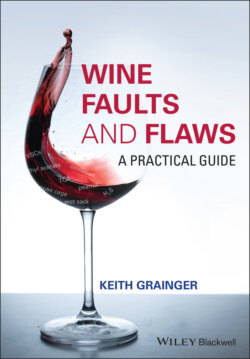Читать книгу Wine Faults and Flaws - Keith Grainger - Страница 32
1.10.3.2 Minimising the Occurrence Chemical Faults
ОглавлениеThe key tools in minimising the risk of the occurrence of chemical faults are as follows.
In the vineyard:
Maintaining sufficient, but not excessive, soil nitrogen levels;
Discontinuing the use of all chemical contact and systemic treatments well before harvesting;
Avoiding using agrochemicals that may break down into unwanted odours compounds such as 2,4‐dichlorophenol and store all agrochemicals away from possible sources of contamination;
Minimising sources of aerial pollution, including the burning of winery rubbish;
Minimising the vineyard presence of pests, particularly ladybug (Coccinellidae) and brown marmorated stink bug (Halyomorpha halys).
In the winery and cellar:
Careful oxygen management – e.g. avoiding ullage in vats and barrels and using gases to sparge equipment, but ensuring that adequate levels of dissolved oxygen are maintained;
Avoiding pick‐up of metals, particularly copper and iron – these metals can be contaminate wine from inappropriate or damaged equipment, particularly valves and fittings;
Maintaining adequate levels of molecular SO2 in wine;
Avoiding possible contact with sources of chemical contamination, e.g. damaged tank linings.
